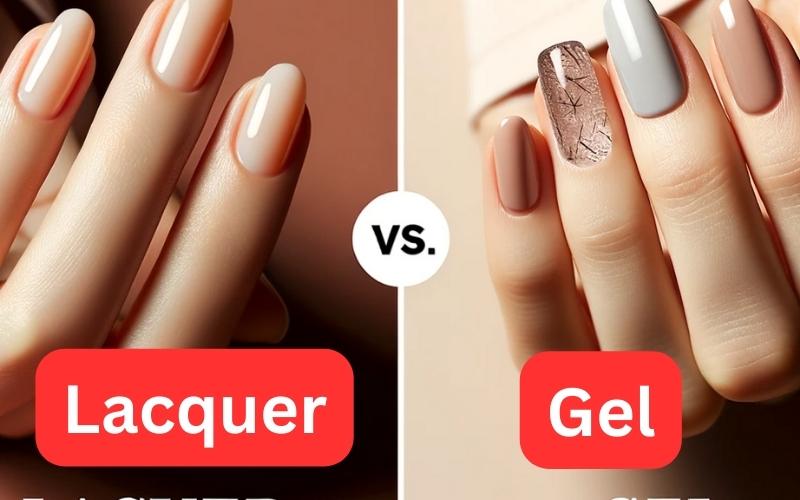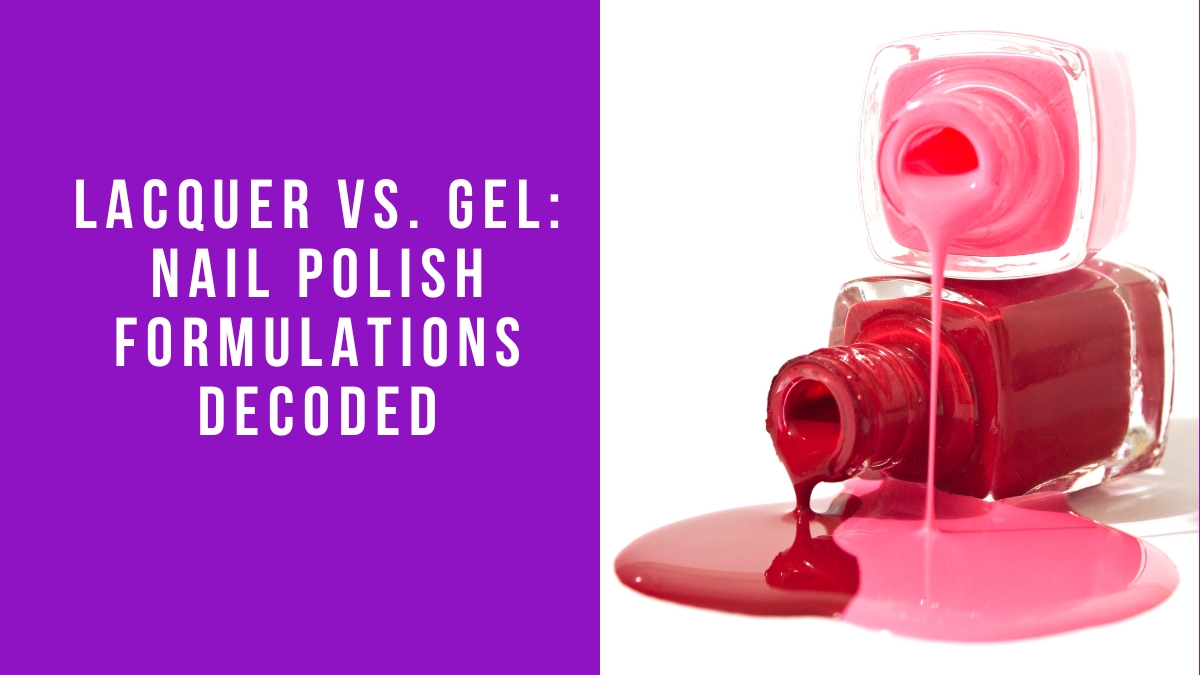Nail polish is a staple in the beauty industry, offering endless possibilities for color and design. However, with so many different formulations available, it can be challenging to understand their differences. In this article, we will decode the differences between nail lacquer and gel polish, two popular types of nail polish.
Nail lacquer and gel polish are both used to add color and shine to nails, but they have distinct differences in their formulations and applications. Nail lacquer is a traditional nail polish applied in thin layers and dries to a hard, glossy finish. It is available in various shades and finishes, from metallic to matte. Nail lacquer is known for its durability and chip-resistant properties, making it a popular choice for everyday wear.

On the other hand, gel polish is a newer type of nail polish that is cured under a UV or LED lamp to create a complex, long-lasting finish. Gel polish is applied in layers, each cured under the lamp before the next layer is applied. It is available in shades and finishes, including glitter and metallic. Gel polish is known for its high shine and long-lasting wear, making it a popular choice for special occasions.
Table of contents
Understanding Nail Polish
Nail polish is a cosmetic product used to decorate and protect nails. It has been a popular beauty item for centuries, with different formulations and finishes available. In this section, we will explore the chemical composition of nail polish, the different types and finishes available, famous brands, application and removal, nail polish care, and the history of nail polish.
Chemical Composition
Nail polish is a solvent-based coating comprising several chemicals, including nitrocellulose, ethyl acetate, and other solvents, pigments, resins, and plasticizers. Nitrocellulose is the main ingredient in nail polish and is responsible for its thickness and quick-drying properties. Ethyl acetate is a solvent that helps to dissolve the nitrocellulose and other ingredients. Pigments are added to give color to the nail polish, while resins and plasticizers help give the polish longevity and flexibility.
Types and Finishes
Nail polish comes in various types and finishes, including glossy, high-gloss, glitter, holographic, and smooth finishes. There are also quick-dry and long-lasting wear formulas available. Some nail polishes have shimmer effects, while others have a matte finish. Popular nail polish brands include OPI, Sally Hansen, Essie, and Butter London.
Popular Brands
OPI is a famous nail polish brand offering over 200 unique shades. Sally Hansen is another renowned brand that provides a range of nail polish finishes, including quick-dry and long-lasting wear formulas. Essie is known for its high-quality nail polish that provides a smooth finish and long-lasting wear. Butter London is a high-end brand that offers a range of nail polish finishes, including high-gloss, glitter, and holographic.
Application and Removal
Nail polish is typically applied in a manicure or pedicure setting. A base coat is applied first to protect the nail and help the polish adhere better. The nail polish is then used in thin layers, with each layer allowed to dry before the next layer is applied. A top coat is applied at the end to seal the polish and provide a shiny finish. Nail polish can be removed using acetone or alcohol-based nail polish remover.
Nail Polish Care
Taking care of your nails and cuticles is essential to keep your nail polish looking its best. Regular manicures and pedicures can help to keep your nails healthy and strong. You should also avoid using your nails as tools and protect them when doing activities that could damage them. Storing your nail polish properly is also essential to prevent it from drying out or becoming too thick.
History of Nail Polish
Nail polish has been used for centuries, with evidence of nail enamel dating back to the 20th century. The first nail polish was likely a transparent, glossy formula made from natural ingredients. Over time, different formulations and finishes were developed, including colored nail varnish and high-gloss finishes. Today, nail polish is a popular beauty item in various colors and finishes.
Decoding Gel Polish
Gel polish is one of the most popular nail polish formulations that offer a long-lasting and chip-resistant manicure. This section will decode the chemical composition, types and finishes, famous brands, application and removal, and gel polish care.
Chemical Composition
Gel polish contains chemicals, thickeners, polymers, solvents, pigments, resins, and plasticizers. The primary difference between gel polish and regular nail polish is that gel polish requires UV light to cure. The curing process hardens the polish, giving it a glossy and long-lasting finish.
Types and Finishes
Gel polish has various finishes, including glossy, high-gloss, glitter, and holographic. Some popular gel polish brands include OPI, Sally Hansen, Essie, and Butter London. OPI offers over 200 unique shades of gel polish, ensuring a color for everyone.
Popular Brands
OPI is one of the most popular gel polish brands, offering a fast-drying formula for up to 7 days of wear. Sally Hansen offers a variety of finishes, including shimmer and smooth finishes. Essie provides a range of colors and finishes, including high-gloss and long-lasting wear. Butter London offers a range of finishes, including glitter and holographic nail polish.
Application and Removal
To apply gel polish, you must prepare your nails by cleaning and buffing them. Then, use a base coat, two coats of gel polish, and a top coat. Depending on the brand, Each layer must cure under a UV light for 30 seconds to 2 minutes. To remove gel polish, use acetone or alcohol-based nail polish remover. Soak a cotton ball in the remover and place it on your nail for 10-15 minutes. Then, use a cuticle pusher to remove the polish gently.
Gel Polish Care
To care for your gel manicure, avoid using your nails as tools and wear gloves when doing household chores. Apply cuticle oil regularly to keep your cuticles moisturized. Avoid picking or peeling the polish off your nails, as this can damage your natural nails. If you want to remove your gel polish, do not peel it off, as this can damage your nails. Instead, gently remove the polish; use acetone or alcohol-based nail polish remover gently.
In summary, gel polish is a durable, long-lasting nail polish formulation with a lustrous and chip-resistant finish. With a range of finishes and colors from popular brands like OPI, Sally Hansen, Essie, and Butter London, gel manicures have become a favorite among nail care enthusiasts. However, it is essential to care for your nails properly and remove the polish gently to avoid damage to your natural nails.
Lacquer vs. Gel
Regarding nail polish formulations, there are two main types: lacquer and gel. While they may look similar, the two have some significant differences. Let’s look closer at the chemical differences, durability and longevity, application and removal, aesthetic differences, and lacquer vs. gel health considerations.
Chemical Differences
Lacquer and gel polish have different chemical compositions. Regular nail polish, also known as nail enamel or varnish, is a type of lacquer. It comprises pigments, solvents, resins, plasticizers, and polymers, with nitrocellulose being the main film-forming ingredient. On the other hand, gel polish contains thickeners, solvents, and resins that are different from those found in lacquer. Ethyl acetate is the primary solvent used in lacquer, while gel polish typically combines oligomers and monomers.
Durability and Longevity
One of the main benefits of gel polish is its durability and long-lasting wear. Gel polish is thicker and more resistant than regular nail polish, making it less prone to chipping and peeling. It can also last up to two weeks without showing signs of wear. However, this long-lasting wear comes at a price. Gel polish is more complicated to remove than regular nail polish and requires special equipment, such as a UV light, to cure.
Application and Removal
Application and removal are also different for lacquer and gel polish. Regular nail polish is easy to apply and dries quickly, making it a popular choice for DIY nail systems. It can be removed with acetone-based nail polish remover. On the other hand, gel polish requires a base coat and top coat and must be cured under UV light. It can only be removed with special gel polish remover, which can be harsh on nails and cuticles.
Aesthetic Differences
Lacquer and gel polish also have aesthetic differences. Lacquer has a glossy finish, while gel polish can have a high-gloss or smooth finish, depending on the brand and type. Gel polish is also available in a broader range of finishes, such as shimmer and lustrous, than regular nail polish.
Health Considerations
Both lacquer and gel polish contain chemicals that can harm nail health if used excessively or improperly. However, gel polish is generally considered safer than acrylic nails or dip powder, as it does not produce air bubbles and does not require harsh chemicals to remove. It is essential to take proper care of nails and cuticles and avoid overusing them.
In summary, lacquer and gel polish have different chemical compositions, durability and longevity, application and removal processes, aesthetic finishes, and health considerations. Choosing the correct type of nail polish depends on individual preferences and needs, as well as the quality and benefits of the product.
Frequently Asked Questions

Does gel nail polish make nails stronger?
Gel nail polish doesn’t necessarily make nails more robust, but it can provide a protective layer that helps prevent breakage. However, it’s important to note that improper gel polish removal can weaken nails. It’s best to have gel polish removed by a professional to avoid damage.
Do nails need a break from gel polish?
Yes, taking a break from gel polish every few months is recommended to give nails a chance to breathe and recover. Overuse of gel polish can cause nails to become weak and brittle.
Gel vs regular polish on acrylic nails – which is better?
Gel polish tends to adhere better to acrylic nails and can last longer than regular polish. However, it’s essential to have the gel polish appropriately removed to avoid damage to the acrylic nails.
Do gel nails cause cancer?
There is no evidence to suggest that gel nails cause cancer. However, using a reputable salon and following proper safety procedures when getting any nail treatment is essential.
How long should a gel manicure last before chipping?
A gel manicure can last up to two weeks without chipping, depending on factors such as nail growth and daily activities. Following proper aftercare instructions is essential to ensure the manicure’s longevity.
What is the difference between nail lacquer and gel nails?
Nail lacquer is a type of regular nail polish that dries through evaporation, while gel nails are cured under a UV or LED light. Gel nails last longer and are more durable than regular polish but require a unique removal process.

Leave a Reply